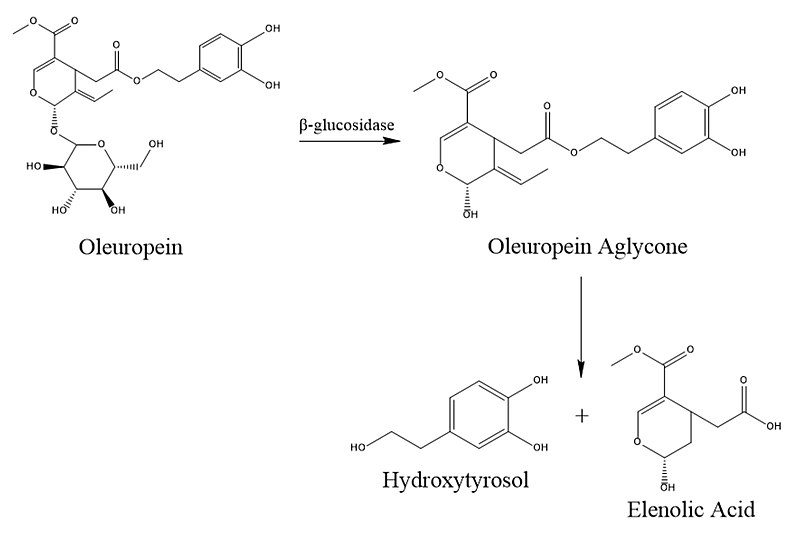ΥΔΡΟΞΥΤΥΡΟΣΟΛΗ

Η υδροξυτυροσόλη είναι φυσική φαινολική ουσία που έχει τον χημικό τύπο (HO)2C6H3CH2CH2OH και είναι ταξινομημένη ως φαινυλαιθανοειδές, δηλαδή, συγγενής ένωση της φαιναιθυλικής αλκοόλης. Τα παράγωγα αυτής ανευρίσκονται σε φυσικές πηγές, κυρίως στο ελαιόλαδο και το κρασί. Ως ένωση είναι άχρωμη και στερεή[1][2] αν και εμπορικά δείγματά της έχουν χρώμα μπεζ. Αποτελεί παράγωγη ένωση της κατεχόλης η παρουσία της οποίας είναι πάρα πολύ σημαντική τόσο στις φαγώσιμες ελιές όσο και στο παρθένο ελαιόλαδο.[3][4]

Η ελευρωπαΐνη, ένα πικρό συστατικό που βρίσκεται στο δέρμα της πράσινης ελιάς, είναι εστέρας της υδροξυτυροσόλης.
Οι
ελιές, τα φύλλα και ο πολτός της ελιάς περιέχουν μεγάλες ποσότητες
παράγωγου της υδροξυτυροσόλης, την ελευρωπαΐνη. Οι μη επεξεργασμένες
πράσινες (άγουρες) ελιές περιέχουν μεταξύ 4,3 και 116 mg υδροξυτυροσόλης
ανά 100 g, ενώ οι μη επεξεργασμένες ώριμες μαύρες ελιές περιέχουν μέχρι
και 413,3 mg ανά 100 g.[5] Η ωρίμανση ελιάς αυξάνει σημαντικά την
ποσότητα της υδροξυτυροσόλης.[6] Οι επεξεργασμένες ελιές, όπως η κοινή
σε κονσέρβα που περιέχει γλυκονικό σίδηρο (II), περιείχαν λίγη
υδροξυτυροσόλη, καθώς τα άλατα σιδήρου είναι καταλύτες για την οξείδωσή
του.[7]

Η υδροξυτυροσόλη θεωρείται ασφαλής ως νέα τροφή για ανθρώπινη κατανάλωση, με επίπεδο μη παρατηρούμενων αρνητικών επιπτώσεων τα 50 mg/kg σωματικού βάρους, ανά ημέρα, όπως αξιολογείται από την Ευρωπαϊκή Αρχή για την Ασφάλεια των Τροφίμων (EFSA).[8]
Στις Ηνωμένες
Πολιτείες, η υδροξυτυροσόλη θεωρείται ασφαλές συστατικό (GRAS) σε
επεξεργασμένα τρόφιμα σε επίπεδα 5 mg ανά μερίδα.[9]
Στη φύση,
η υδροξυτυροσόλη παράγεται μετά από την υδρόλυση της ελευρωπαΐνης που
συμβαίνει κατά την ωρίμανση της ελιάς. Η ελευρωπαΐνη συσσωρεύεται στα
φύλλα και στους καρπούς της ελιάς ως αμυντικός μηχανισμός (βλ.
δευτερογενείς μεταβολίτες) έναντι παθογόνων και φυτοφάγων
μικροοργανισμών.
Κατά την ωρίμανση της ελιάς ή όταν η ελιά
έχει υποστεί υποβάθμιση από παθογόνα ή από μηχανική βλάβη, το ένζυμο
β-γλυκοσιδάση καταλύει τη σύνθεση υδροξυτυροσόλης μέσω υδρόλυσης από την
ελευρωπαΐνη.[10]

Οι μεσογειακές δίαιτες, που χαρακτηρίζονται από τακτική πρόσληψη
ελαιολάδου, έχει αποδειχθεί ότι επηρεάζουν θετικά την ανθρώπινη υγεία,
συμπεριλαμβανομένων των μειωμένων ποσοστών καρδιαγγειακών
παθήσεων.[3][11][12] Η έρευνα για την κατανάλωση ελαιολάδου και των
συστατικών του περιλαμβάνει υδροξυτυροσόλη και ελευρωπαΐνη, που μπορεί
να αναστείλουν την οξείδωση της LDL χοληστερόλης – παράγοντα κινδύνου
για αθηροσκλήρωση, καρδιακή προσβολή ή εγκεφαλικό.[13]
Η ημερήσια πρόσληψη υδροξυτυροσόλης στη μεσογειακή διατροφή εκτιμάται ότι είναι μεταξύ 0,15 και 30 mg/ημέρα. [14]
Η
Ευρωπαϊκή Αρχή για την Ασφάλεια των Τροφίμων έχει εκδώσει επιστημονική
γνώμη σχετικά με τους ισχυρισμούς υγείας σε σχέση με τη διατροφική
κατανάλωση υδροξυτυροσόλης και συναφών ενώσεων πολυφαινόλης από φρούτα
και ελαιόλαδο και την προστασία των λιπιδίων του αίματος από πιθανή
οξειδωτική βλάβη.[15]
Η Αρχή κατέληξε επίσης στο συμπέρασμα
ότι υπήρχε σχέση αιτίου-αποτελέσματος μεταξύ της κατανάλωσης
υδροξυτυροσόλης και φαινολικών ενώσεων από ελιές και ελαιόλαδο και την
προστασία των λιπιδίων του αίματος από οξειδωτική βλάβη,[15] παρέχοντας
ισχυρισμό υγείας για κατανάλωση πολυφαινολών ελαιολάδου που περιέχουν
τουλάχιστον 5 mg υδροξυτυροσόλης και των παραγώγων της (σύμπλεγμα
ελευρωπαΐνης και τυροσόλη) ανά 20 g ελαιολάδου.[16]
Παραπομπές
1.
«Factors influencing phenolic compounds in table olives (Olea
europaea)». Journal of Agricultural and Food Chemistry 60 (29):
7081–7095. July 2012. doi:10.1021/jf3017699. PMID 22720792.
2.
«Hydroxytyrosol, Tyrosol and Derivatives and Their Potential Effects on
Human Health». Molecules 24 (10): 2001. May 2019.
doi:10.3390/molecules24102001. PMID 31137753.
3. «Bioactive
compounds in wine: Resveratrol, hydroxytyrosol and melatonin: A review».
Food Chemistry 130 (4): 797–813. 2012-02-15.
doi:10.1016/j.foodchem.2011.08.023. ISSN 0308-8146.
4.
«Hydroxytyrosol and its potential therapeutic effects». Journal of
Agricultural and Food Chemistry 62 (7): 1449–1455. February 2014.
doi:10.1021/jf405820v. PMID 24479643.
5. «Showing all foods in
which the polyphenol Hydroxytyrosol is found - Phenol-Explorer».
phenol-explorer.eu. Ανακτήθηκε στις 2 Ιουλίου 2021.
6. «Table olives and health: a review». Journal of Nutritional Science 9: e57. 2020. doi:10.1017/jns.2020.50. PMID 33354328.
7.
«Phenolic compounds change during California-style ripe olive
processing». Food Chemistry 74 (1): 55–60. July 2001.
doi:10.1016/S0308-8146(00)00338-1.
8. «Safety of hydroxytyrosol
as a novel food pursuant to Regulation (EC) No 258/97». EFSA Journal.
European Food Safety Authority 15 (3): e04728. March 2017.
doi:10.2903/j.efsa.2017.4728. PMID 32625437.
9. «GRAS notice for hydroxytyrosol». US Food and Drug Administration. 13 Μαΐου 2016. Ανακτήθηκε στις 2 Ιουλίου 2021.
10.
«Factors influencing phenolic compounds in table olives (Olea
europaea)». Journal of Agricultural and Food Chemistry 60 (29):
7081–7095. July 2012. doi:10.1021/jf3017699. PMID 22720792.
11.
«Hydroxytyrosol and its potential therapeutic effects». Journal of
Agricultural and Food Chemistry 62 (7): 1449–1455. February 2014.
doi:10.1021/jf405820v. PMID 24479643.
12. «The Mediterranean Diet
and Cardiovascular Health». Circulation Research 124 (5): 779–798.
March 2019. doi:10.1161/CIRCRESAHA.118.313348. PMID 30817261.
13.
«Effects of Olive Oil and Its Minor Components on Cardiovascular
Diseases, Inflammation, and Gut Microbiota». Nutrients 11 (8): 1826.
August 2019. doi:10.3390/nu11081826. PMID 31394805.
14.
«Hydroxytyrosol protects from aging process via AMPK and autophagy; a
review of its effects on cancer, metabolic syndrome, osteoporosis,
immune-mediated and neurodegenerative diseases». Pharmacological
Research 143: 58–72. May 2019. doi:10.1016/j.phrs.2019.03.005. PMID
30853597.
15. «Scientific Opinion on the substantiation of health
claims related to polyphenols in olive and protection of LDL
particles». European Food Safety Authority (στα Αγγλικά). Ανακτήθηκε
στις 13 Απριλίου 2021. From oxidative damage (ID 1333, 1638, 1639, 1696,
2865), maintenance of normal blood HDL cholesterol concentrations (ID
1639), maintenance of normal blood pressure (ID 3781),
“anti-inflammatory properties” (ID 1882), “contributes to the upper
respiratory tract health” (ID 3468), “can help to maintain a normal
function of gastrointestinal tract” (3779), and “contributes to body
defences against external agents” (ID 3467) pursuant to Article 13(1) of
Regulation (EC) No 1924/2006
16. «EU Register of nutrition and health claims made on foods (v.3.6)». ec.europa.eu. Ανακτήθηκε στις 13 Απριλίου 2021.
